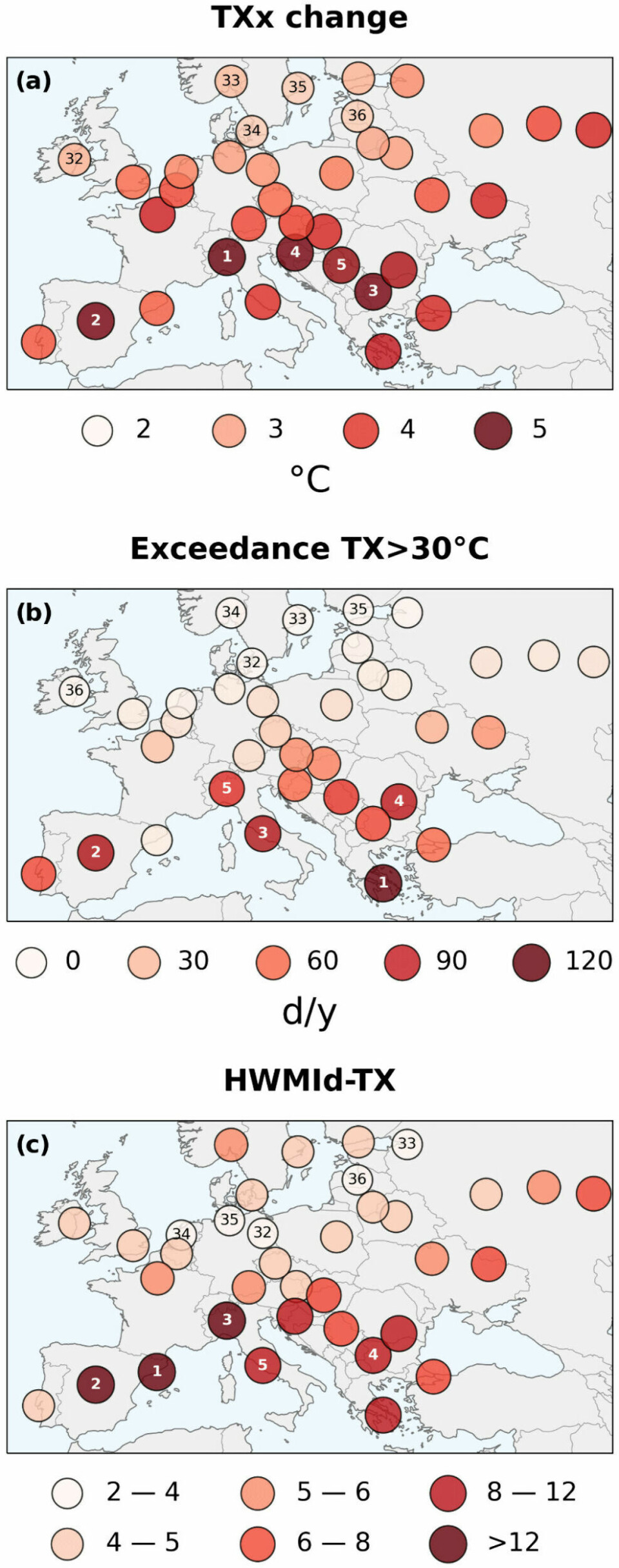
How often will European cities experience temperatures above 30°C in the future?
If temperatures rise by three degrees, cities in southern Europe will have dozens more days each year with temperatures above 30 degrees, according to a new study.
Researchers used climate models to predict what will happen if Europe’s temperatures increase by three degrees compared to the period from 1981 to 2010.
“Unfortunately, we see an increase in heat for all cities, contributing to increased heat stress,” says Anne Sophie Daloz, a researcher at CICERO Center for International Climate Research.
Researchers at CICERO are among those who have participated in the study.
- The results show that Athens could have around 120 days a year with temperatures exceeding 30 degrees in such a scenario.
- Rome and Madrid could have around 90 days with temperatures over 30 degrees. Today, Rome has around 62 days with temperatures exceeding 30 degrees, according to currentresults.com.
- In Oslo, there will be little change, according to this study. However, Oslo and other cities in the Nordic region will experience more unusually warm days in a row.

Health risks
There are several reasons why Anne Sophie Daloz and her colleagues wanted to study cities in a warmer climate.
“Firstly, it’s because heat stress is expected to increase with global warming,” she says.
By heat stress, the researchers mean health problems that people may experience due to the heat. Children and the elderly are especially vulnerable.
“We’re concerned about cities because 75 per cent of the population in Europe lives in cities. People live close together, and on top of that, we have the urban heat island effect,” she says.
The urban heat island effect means that city centres are often warmer than the surrounding rural areas. This is due to more asphalt, more buildings, and less nature, according to sciencedirect.com.

Better resolution
In the past, climate models did not have good enough resolution for researchers to assess future heat in a large number of cities.
This is now possible, says Daloz. The researchers used climate models that provide a resolution where each grid cell corresponds to approximately 12 kilometres.
They looked at warming in 36 large European cities. In the scenario, the temperature rises by three degrees above the average from 1981 to 2010.
This corresponds to a global temperature increase of three degrees above pre-industrial levels.
The temperature increase is slightly higher than what is expected with current policies, which, if unchanged, will result in a temperature increase of about 2.7 degrees in 2100, according to the Climate Action Tracker.
Increasing most in the south and inland cities
The new study is part of the EU EXHAUSTION project, which deals with the effects of heat stress and air pollution in Europe.
Most viewed
The study shows that cities in southern Europe will be especially affected by the rise in temperature.
The researchers made three different calculations. They looked at changes in maximum temperature, the number of days over 30 degrees, and the duration and intensity of heatwaves.
The maximum temperature, the hottest days of the year, will be five degrees warmer in Milan, Madrid, Sofia, and Zagreb.
These are cities in southern Europe, all located inland and not coastal.
The increase in maximum temperature gradually becomes smaller the further north we go. For Oslo, the study shows an increase in maximum temperature of up to three degrees.

More tropical days
Southern cities will experience the highest number of days with temperatures exceeding 30 degrees. This is not surprising, as the temperature is already higher there.
Athens, Madrid, Rome, Bucharest, and Milan are projected to have the most hot days, with 80 to 120 days a year reaching at least 30 degrees.
Several central European cities will also see a high number of these tropical days. In northern Europe, the study shows few days over 30 degrees: fewer than two days in Oslo.
“However, this study is based on an average over many years, so individual years can have more days where temperatures exceed 30 degrees,” says Daloz.
Longer and stronger heatwaves
The picture changes somewhat when researchers look at the length and strength of heatwaves. This is calculated using a method called the Heat Wave Magnitude Index daily.
The definition of a heatwave varies by country, based on typical temperatures in the current climate. In the index, heatwaves are defined as at least three days with abnormal temperatures for the given month.
“The index captures the length and strength of heatwaves,” says Daloz.
Calculations show that southern European cities experience the worst heat. Spanish and Italian cities will have stronger and longer heatwaves.
Cities in the north, such as Oslo, Copenhagen, and Stockholm, however, rank higher on the scale than countries slightly further south.
In the researchers' scenario, we see an increase in the length and intensity of heatwaves – consecutive days with abnormally high temperatures.
“This shows that heat stress is also a concern for those who live in the Nordic countries,” she says.
Different measures of heat
Cities are affected differently depending on whether researchers look at maximum temperature, heatwaves, or the number of days temperatures exceed 30 degrees.
“It’s therefore important to look at different calculations to get a good picture of the changes,” says Daloz.
She says the study shows that Europe will have more problems with heat stress in the future. This is especially problematic for vulnerable groups in the population. The Nordic countries will not be unaffected, even though it is colder here.
“Here, I’m only talking about human health. But we also know that high temperatures combined with, for example, drought can cause major problems for nature and can have long-term impacts,” she says.
One limitation of the study is that a 12-kilometre resolution still provides a simplified view of the climate in cities. The researchers did not find a clear urban heat island effect, which may be due to the simplified representation of cities. Making heat predictions at the city level is crucial so that cities can plan adaptation measures, the researchers write.
Important topic, but uncertain results
Rasmus Benestad, a climate researcher at the Norwegian Meteorological Institute, has reviewed the study.
“The article addresses an important topic, is a step towards better understanding, and shows several interesting results. However, I consider these results insufficient for driving climate adaptation,” says Benestad.
“Regional climate modelling still yields uncertain results, which is evident in the article, and there are various opinions about the methods used.”
Benestad finds the figure presenting the main results (shown above) somewhat unclear regarding which of the various simulations with different climate models are being referenced.
He also finds it odd that the study shows almost no increase in the number of days in Oslo with temperatures over 30 degrees if Europe’s temperature rises by three degrees.
“If we look at temperature measurements at Oslo-Blindern, we see an average of 1.3 days a year with more than 30 degrees. We expect to see many more days with three degrees of warming in Oslo. If we simply add three degrees to historical measurements, we get 7.3 days per year,” he says.
Stretching the findings
Benestad agrees that greater warming is expected around the Mediterranean area and that a four-degree increase in summer aligns with previous estimates.
“However, I'm a bit unsure about the number of days over 30 degrees. If nearly every day in the summer half-year in Athens will be that hot in the future, it depends on the extent of temperature fluctuations we can expect,” he says.
“I’m also not convinced that the regional climate models in Euro-CORDEX can accurately replicate urban heat islands or city temperatures. This is an area of active research.”
Euro-CORDEX is a collection of regional climate model simulations used in the study.
“Although such models have a spatial resolution that allows a city to be covered with a few grid cells, all such models have a minimum scale for realistic information based on the way they are constructed,” he says.
“Moreover, the original purpose of CORDEX was to compare regional climate models, and I believe they’re stretching their use when applying them to city temperatures.”
Important to combine methods
A weakness of the results is that they focus solely on so-called dynamic downscaling, says Benestad.
“It’s important to combine such downscaling with empirical-statistical downscaling,” he says.
He explains that there are two main ways to calculate local temperatures. One is a weather forecasting model based on physical laws, and the other relies on measurement data and statistics. Both should provide the same answer but are based on different assumptions.
“Because both produce uncertain results, it’s important to use and compare both,” he says.
———
Translated by Alette Bjordal Gjellesvik
Read the Norwegian version of this article on forskning.no
Reference:
Schwingshackl et al. High-resolution projections of ambient heat for major European cities using different heat metrics, Natural Hazards and Earth System Sciences, 2024. DOI: 10.5194/nhess-24-331-2024






































